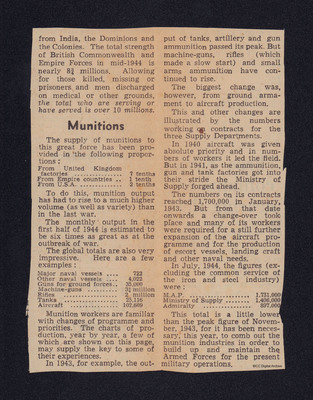Article covering British war effort
Title
Article covering British war effort
Description
Mentions total strength of British Empire and Commonwealth forces in mid 1944. Lists munitions and ships produced as well as mentioning aircraft, tanks, artillery and other weapons. Mentions number of contracts, change from ground to air armament with aircraft given priority in 1940.
Temporal Coverage
Language
Type
Format
One newspaper cutting
Publisher
Rights
This content is available under a CC BY-NC 4.0 International license (Creative Commons Attribution-NonCommercial 4.0). It has been published ‘as is’ and may contain inaccuracies or culturally inappropriate references that do not necessarily reflect the official policy or position of the University of Lincoln or the International Bomber Command Centre. For more information, visit https://creativecommons.org/licenses/by-nc/4.0/ and https://ibccdigitalarchive.lincoln.ac.uk/omeka/legal.
Identifier
SValentineJRM1251404v10092
Transcription
from India, the Dominions and the Colonies. The total strength of British Commonwealth and Empire Forces in mid-1944 is nearly 8 3/4 millions. Allowing for those killed, missing or prisoners and men discharged on medical or other grounds, [italics] the total who are serving or have served is over 10 millions. [/italics]
Munitions
The supply of munitions to this great force has been provided in the following proportions:
From United Kingdom factories . . . 7 tenths
From Empire countries . . . 1 tenth
From U.S.A. . . . 2 tenths
To do this, munition output has had to rise to a much higher volume (as well as variety) than in the last war.
The monthly output in the first half of 1944 is estimated to be six times as great as at the outbreak of war.
The global totals are also very impressive. Here are a few examples:
Major naval vessels . . . 722
Other naval vessels . . . 4,022
Guns for ground forces . . . 35,000
Machine-guns . . . 3 3/4 million
Rifles . . . 2 million
Tanks . . . 25,116
Aircraft . . . 102,609
Munition workers are familiar with changes of programme and priorities. The charts of production, year by year, a few of which are shown on this page, may supply the key to some of their experiences.
In 1943, for example, the output of tanks, artillery and gun ammunition passed its peak. But machine-guns, rifles (which made a slow start) and small arms ammunition have continued to rise.
The biggest change was, however, from ground armament to aircraft production.
This and other changes are illustrated by the numbers working on contracts for the three Supply Departments.
In 1940 aircraft was given absolute priority and in numbers of workers it led the field. But in 1941, as the ammunition, gun and tank factories got into their stride the Ministry of Supply forged ahead.
The numbers on its contracts reached 1,700,000 in January, 1943. But from that date onwards a change-over took place and many of its workers were required for a still further expansion of the aircraft programme and for the production of escort vessels, landing craft and other naval needs.
In July, 1944, the figures (excluding the common services of the iron and steel industry) were:
M.A.P. . . . 1,731,000
Ministry of Supply . . . 1,406,000
Admiralty . . . 897,000
This total is a little lower than the peak figure of November, 1943, for it has been necessary, this year, to comb out the munition industries in order to build up and maintain the Armed Forces for the present military operations.
Munitions
The supply of munitions to this great force has been provided in the following proportions:
From United Kingdom factories . . . 7 tenths
From Empire countries . . . 1 tenth
From U.S.A. . . . 2 tenths
To do this, munition output has had to rise to a much higher volume (as well as variety) than in the last war.
The monthly output in the first half of 1944 is estimated to be six times as great as at the outbreak of war.
The global totals are also very impressive. Here are a few examples:
Major naval vessels . . . 722
Other naval vessels . . . 4,022
Guns for ground forces . . . 35,000
Machine-guns . . . 3 3/4 million
Rifles . . . 2 million
Tanks . . . 25,116
Aircraft . . . 102,609
Munition workers are familiar with changes of programme and priorities. The charts of production, year by year, a few of which are shown on this page, may supply the key to some of their experiences.
In 1943, for example, the output of tanks, artillery and gun ammunition passed its peak. But machine-guns, rifles (which made a slow start) and small arms ammunition have continued to rise.
The biggest change was, however, from ground armament to aircraft production.
This and other changes are illustrated by the numbers working on contracts for the three Supply Departments.
In 1940 aircraft was given absolute priority and in numbers of workers it led the field. But in 1941, as the ammunition, gun and tank factories got into their stride the Ministry of Supply forged ahead.
The numbers on its contracts reached 1,700,000 in January, 1943. But from that date onwards a change-over took place and many of its workers were required for a still further expansion of the aircraft programme and for the production of escort vessels, landing craft and other naval needs.
In July, 1944, the figures (excluding the common services of the iron and steel industry) were:
M.A.P. . . . 1,731,000
Ministry of Supply . . . 1,406,000
Admiralty . . . 897,000
This total is a little lower than the peak figure of November, 1943, for it has been necessary, this year, to comb out the munition industries in order to build up and maintain the Armed Forces for the present military operations.
Citation
“Article covering British war effort,” IBCC Digital Archive, accessed July 22, 2024, https://ibccdigitalarchive.lincoln.ac.uk/omeka/collections/document/22075.
Item Relations
This item has no relations.

